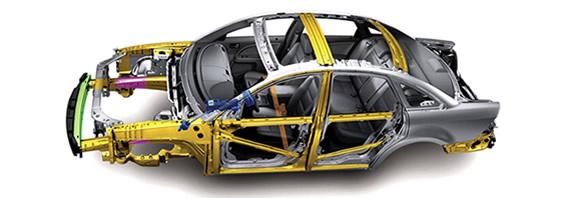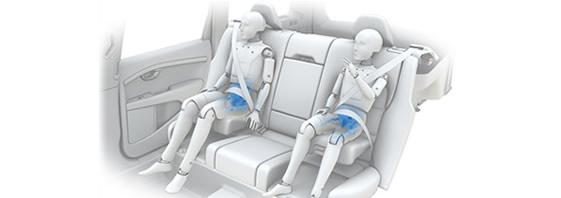Vehicle Safety
Safer Vehicles
In This Section
- Accident Avoidance Technologies
- Occupant Protection Technologies
- Post-Crash/Injury Mitigation Technologies
Occupant Protection Technologies
Many factors influence a vehicle's crashworthiness, including the design of the vehicle's structure to absorb impact energy and the use of passive safety equipment such as air bags. To help protect drivers and passengers in the event of a crash, a variety of Ford technologies have been designed to enhance the performance of safety belts and air bags and provide additional occupant protection in side crashes and rollovers.

The Safety Canopy
Ford was the first in the industry to offer rollover-activated side-curtain air bags, known as the Safety Canopy®, beginning with the Ford Explorer and Mercury Mountaineer in 2002. Today, the Safety Canopy with rollover sensors – which helps reduce the risk of injury to vehicle occupants during side-impact collisions and rollover accidents – is available on most Ford vehicles, including the Ford Focus, Fusion, Taurus, Taurus X, Flex, Edge, Escape, Explorer, SportTrac, Expedition and F-Series; the Mercury Milan, Sable, Mariner and Mountaineer; and the Lincoln MKZ, MKS, MKX and Navigator. By the 2010 model year, all Ford, Lincoln and Mercury retail SUVs and crossovers, as well as vans and trucks under 8,500 lbs., are planned to have the Safety Canopy as standard equipment. Ford already has more than 1.5 million vehicles on the road with Safety Canopy rollover-activated curtains.

SPACE™ Architecture
The 2009 Ford Taurus, Taurus X, Flex, Mercury Sable and Lincoln MKS have been engineered with crush zones designed to direct excess energy around the passenger compartment into a high-strength frame. This advanced engineering design – known as SPACE™ Architecture – utilizes crash form management techniques to help channel impact forces around and away from the passenger cabin.

Integrated two-stage booster seat, which helps to protect children who have outgrown their toddler seat
Another new technology – which launched on the 2008 Volvo V70 and XC70 and received numerous accolades – is the integrated two-stage booster seat, which helps to protect children who have outgrown their toddler seat. The system received Popular Science's annual Best of What's New award, as well as the World Traffic Safety Symposium's award for best new safety feature, presented at the 2007 New York International Auto Show.
With this system, a separate booster cushion is not required; instead, the base of the rear seats lifts up, placing the child in the correct position relative to the safety belt. The system includes two settings: the upper setting is designed for children measuring 95–120 cm and weighing 15–25 kg, while the lower setting is intended for children 115–140 cm in height and weighing 22–36 kg. When the integrated boosters are not raised, the seats are indistinguishable from rear seats without this option, and both fold flat to expand the cargo compartment.
In Europe, the Ford Mondeo, S-MAX and Galaxy are equipped with an Inflatable Knee Bolster, designed to help reduce the driver's forward motion in the event of a severe frontal crash and reduce the risk of injury to lower limbs. This technology is expected to be available on select Ford vehicles in the U.S. for the 2010 model year.
Safety belts remain the most important vehicle safety technology available. Responding to the changing demographics of today's driving population, Ford is researching advanced, next-generation safety belt technologies that could help to further reduce the number of annual vehicle fatalities, which are already at their lowest levels since 1994 in developed countries.
One new design under development, envisioned for possible use in rear seats, incorporates an air bag into the safety belt itself. In this design, a tube of air bag material is hidden in the safety belt webbing, and the tube inflates into a cylindrical shape when the frontal air bags deploy. The inflatable belts have the potential to spread the forces from a vehicle crash over a broader section of the body than a traditional safety belt, which may help to reduce pressure on the chest. At the same time, the bag may help to control the motion of the head and neck.
Research and evaluations have shown that the inflatable belt may effectively enhance the protection of occupants in the rear seat, including children and the elderly. When not inflated, the thicker belt was judged in consumer clinics to be more comfortable than a standard safety belt, because it felt like it was padded. A developmental version of the inflatable belt system was shown on a concept car at the Detroit Auto Show in January 2006.
Finally, as smaller and more fuel-efficient vehicles become more popular, the safety of smaller cars is sometimes raised as a concern. Ford's study of accident trends found that fatality rates for small cars of the 1990s were lower than for large cars of the 1970s, due to improvements in vehicle safety, changing driver behavior such as increased seat-belt usage and generally safer road infrastructure.
Ford's focus is to continue making small cars even safer while building larger vehicles that are more crash compatible with smaller vehicles. We’ve already lowered the front bumper structures on most of our crossovers, SUVs and pickups to help them better match up with small vehicle crash structures. We also are taking weight out of larger vehicles while helping to maintain their crashworthiness with advanced, high-strength yet lightweight material in crash structures. The all-new 2009 F-150 is a good example with use of boron – the strongest weldable metal – and other exotic materials in the crash structure that helped us achieve the segment's best crash-test ratings and unsurpassed fuel economy while maintaining the vehicle's weight even as we added more standard safety equipment.
Related Links
- Vehicle Web Sites:
- Ford Focus
- Ford Fusion
- Ford Taurus
- Ford Taurus X
- Ford Edge
- Ford Flex
- Ford Escape
- Ford Explorer
- Ford SportTrac
- Ford Expedition
- Ford F-150
- Mercury Sable
- Mercury Milan
- Mercury Mountaineer
- Mercury Mariner
- Lincoln MKZ
- Lincoln MKX
- Lincoln MKS
- Lincoln Navigator
- Volvo V70
- Volvo XC70
- Ford Mondeo
- Ford S-MAX
- Ford Galaxy